UH LOOKING TO BUILD NEW CAMPUS IN KATY, BECAUSE THAT’S WHERE THE ENERGY IS  The University of Houston has asked state lawmakers to begin work on a $60 million tuition revenue bond that would fund a new campus in Katy, including a 60,000-sq.-ft. facility on a not-yet-identified site. The new campus would be separate from the system’s existing facility at 4242 S. Mason Rd. in Cinco Ranch (pictured above). The move closer to oil and gas firms in the Energy Corridor is part of what UH vice president for government and community affairs Jason Smith tells Community Impact news is the institution’s goal “to become the energy university for the United States.” The Katy campus “would serve the oil and gas interests there, the companies and their campuses there,” he says. Separately, university president Renu Khator last week called the award of a multi-million-dollar grant for the establishment of a UH-led Subsea Systems Institute “the culmination of years of work to establish the University of Houston as the Energy University.” (Grant monies for that institute will come from payments made by oil company BP to the state of Texas after the 2010 Deepwater Horizon oil spill.) [Community Impact News; UH] Photo of University of Houston System at Cinco Ranch: Directron
The University of Houston has asked state lawmakers to begin work on a $60 million tuition revenue bond that would fund a new campus in Katy, including a 60,000-sq.-ft. facility on a not-yet-identified site. The new campus would be separate from the system’s existing facility at 4242 S. Mason Rd. in Cinco Ranch (pictured above). The move closer to oil and gas firms in the Energy Corridor is part of what UH vice president for government and community affairs Jason Smith tells Community Impact news is the institution’s goal “to become the energy university for the United States.” The Katy campus “would serve the oil and gas interests there, the companies and their campuses there,” he says. Separately, university president Renu Khator last week called the award of a multi-million-dollar grant for the establishment of a UH-led Subsea Systems Institute “the culmination of years of work to establish the University of Houston as the Energy University.” (Grant monies for that institute will come from payments made by oil company BP to the state of Texas after the 2010 Deepwater Horizon oil spill.) [Community Impact News; UH] Photo of University of Houston System at Cinco Ranch: Directron
Schools

Sources tell Swamplot that the River Oaks Baptist School is buying the building occupied by Walgreens at 3900 Westheimer Rd., at the southern end of the school’s campus on Willowick Rd. The school will reportedly use the 1.8-acre property vacated by the drug-store chain (and pictured above) for a “possible parking garage and secondary exit onto Westheimer.”
Walgreens won’t be leaving the Highland Village area, however. Workers are already transforming the former Fresh Market grocery store at 3745 Westheimer Rd. (pictured below) into a new Walgreens. It’s currently scheduled to open in March:
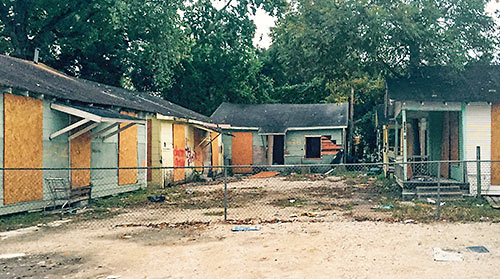
Demos appear to be ready to commence on a good-sized swath of Independence Heights surrounding Booker T. Washington High School at 119 East 39th St.
“Seems everything between Yale and Main is about to be bulldozed… an entire neighborhood vanishing,” writes a reader. “It’s really kinda spooky looking — like an abandoned ghost town”:
SAY SALAAM TO THE SHADY ACRES HOME OF HOUSTON’S FIRST ARABIC IMMERSION SCHOOL 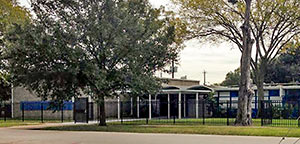 Here’s where some of Houston’s future bilingual Arabic-English speakers will learn their two alphabets: HISD’s former Holden Elementary and
Here’s where some of Houston’s future bilingual Arabic-English speakers will learn their two alphabets: HISD’s former Holden Elementary and the current home of more recently the Energy Institute High School at 812 W. 28th. St., just across N. Durham St. from a ramshackle flower shop just inside the North Loop. An energy school giving way to Arabic-language instruction? Synergy? Arabic trails only Spanish (and English) among languages HISD students speak at home, according to statistics from the district. Interested parents of rising pre-kindergartners and kindergartners were able to start applying last Friday for the magnet program slated to begin next Fall. Two each of pre-K and kindergarten classes will comprise the school’s first classes next year. If the district’s first Arabic immersion school is to operate the same way the existing Spanish- and Mandarin-English HISD schools do, students will be taught half in English and half in Modern Standard Arabic. [HISD] Photo: Swamplot Inbox
COMMENT OF THE DAY: SCHOOL CHOICE  “. . . You have hit upon an issue that is at the core of not only the perception of school quality but also a prime driver of the residential real estate market, especially in the suburbs (and thereby a driver of retail and office markets as well). In my admittedly qualitative, non-scientific observation of the dialogue surrounding schools, the general public perception of school quality is not nearly driven as much by teaching methods, administrative / management styles, or teacher qualifications, as by the demographics of the students themselves. In the greater public’s mind, affluent demographics = good schools, with the demographics being the more independent variable (though there’s obviously a feedback loop as more affluent home buyers will be drawn to schools with already affluent students). Private schools are obviously not as related to real estate (with Strake Jesuit as an example), but the perception issue seems as relevant.
To put the issue another way, is a student from an affluent household likely to perform worse academically if he/she attends a school with less affluent demographics? My sense is, many people seem to think so and make school enrollment decisions accordingly. Perhaps this assertion is justified by empirical data and experience, I don’t know.” [Local Planner, commenting on How The Woodlands Has Gone Astray; A Suitable Houston Honor for the Inventor of Air Conditioning] Illustration: Lulu
“. . . You have hit upon an issue that is at the core of not only the perception of school quality but also a prime driver of the residential real estate market, especially in the suburbs (and thereby a driver of retail and office markets as well). In my admittedly qualitative, non-scientific observation of the dialogue surrounding schools, the general public perception of school quality is not nearly driven as much by teaching methods, administrative / management styles, or teacher qualifications, as by the demographics of the students themselves. In the greater public’s mind, affluent demographics = good schools, with the demographics being the more independent variable (though there’s obviously a feedback loop as more affluent home buyers will be drawn to schools with already affluent students). Private schools are obviously not as related to real estate (with Strake Jesuit as an example), but the perception issue seems as relevant.
To put the issue another way, is a student from an affluent household likely to perform worse academically if he/she attends a school with less affluent demographics? My sense is, many people seem to think so and make school enrollment decisions accordingly. Perhaps this assertion is justified by empirical data and experience, I don’t know.” [Local Planner, commenting on How The Woodlands Has Gone Astray; A Suitable Houston Honor for the Inventor of Air Conditioning] Illustration: Lulu
COMMENT OF THE DAY: WHAT I SHOULD HAVE SAID ABOUT STRAKE JESUIT  “If people want to self-segregate and move somewhere like The Woodlands, great. I’m glad they are free to do that. What I don’t understand is the myopia that self-segregation can create, when people forget that anyone would ever value anything else over clean and shiny (and white) suburbs.
An example of what bothers me so much: I was leaving a Strake Jesuit football game earlier this year, and a Woodlands dad and I fell into conversation on the way out. He commented “this is such a great campus. Too bad it’s in this neighborhood.†As a SJ parent, I didn’t have any choice but to answer him politely, so I murmured something about how the lower property costs made it possible for the school to buy more land to improve and expand. But in reality, I was just incensed by his comments — still am, actually. What, a working class neighborhood doesn’t deserve something nice like a private school campus in it? The school has nothing to offer the neighborhood, and vice versa? The neighborhood has less value in absolute terms because it’s not wealthy, or aesthetically pleasing? What is it about living somewhere like The Woodlands that changes the way a person thinks, that they can look at the (abundant) life going on outside their clean little bubble and not recognize its value? I don’t have an answer to this question — it just bothers me an awful lot.” [Vonnegan, commenting on How The Woodlands Has Gone Astray; A Suitable Houston Honor for the Inventor of Air Conditioning] Illustration: Lulu
“If people want to self-segregate and move somewhere like The Woodlands, great. I’m glad they are free to do that. What I don’t understand is the myopia that self-segregation can create, when people forget that anyone would ever value anything else over clean and shiny (and white) suburbs.
An example of what bothers me so much: I was leaving a Strake Jesuit football game earlier this year, and a Woodlands dad and I fell into conversation on the way out. He commented “this is such a great campus. Too bad it’s in this neighborhood.†As a SJ parent, I didn’t have any choice but to answer him politely, so I murmured something about how the lower property costs made it possible for the school to buy more land to improve and expand. But in reality, I was just incensed by his comments — still am, actually. What, a working class neighborhood doesn’t deserve something nice like a private school campus in it? The school has nothing to offer the neighborhood, and vice versa? The neighborhood has less value in absolute terms because it’s not wealthy, or aesthetically pleasing? What is it about living somewhere like The Woodlands that changes the way a person thinks, that they can look at the (abundant) life going on outside their clean little bubble and not recognize its value? I don’t have an answer to this question — it just bothers me an awful lot.” [Vonnegan, commenting on How The Woodlands Has Gone Astray; A Suitable Houston Honor for the Inventor of Air Conditioning] Illustration: Lulu

Here’s a cutaway view looking into what’s being called the final design of the new Downtown campus for Houston’s High School for the Performing and Visual Arts. Escalating construction costs have spurred HISD to accelerate the 2012 bond program that’s paying for the new HSPVA campus along with rebuilding programs at approximately 40 schools. So construction on the 5-story, 168,000-sq.-ft. building designed by the Houston office of Gensler is expected to begin within a few weeks, and end shortly after the 2017 school year begins.

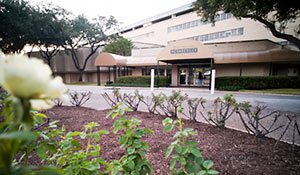 HISD intends to demolish the last remaining non-garage portion of the Shamrock Hotel complex early next year as part of its plans for a new DeBakey High School for Health Professions. The Shamrock’s former ballroom (pictured at right), now called the Edwin Hornberger Conference Center, has been operated as an event space by Trevisio Restaurant since 2011, but closed in May of this year. That structure will be scrapped, but the parking garage that shares the conference center’s 2151 W. Holcombe Blvd. address will remain, according to renderings of the new high school project. (The garage is the building bathed in white at right in the rendering above.)
HISD intends to demolish the last remaining non-garage portion of the Shamrock Hotel complex early next year as part of its plans for a new DeBakey High School for Health Professions. The Shamrock’s former ballroom (pictured at right), now called the Edwin Hornberger Conference Center, has been operated as an event space by Trevisio Restaurant since 2011, but closed in May of this year. That structure will be scrapped, but the parking garage that shares the conference center’s 2151 W. Holcombe Blvd. address will remain, according to renderings of the new high school project. (The garage is the building bathed in white at right in the rendering above.)
HCC IS PLANNING A STUDENT DORM BUILDING TOO, AT ALABAMA AND ALMEDA 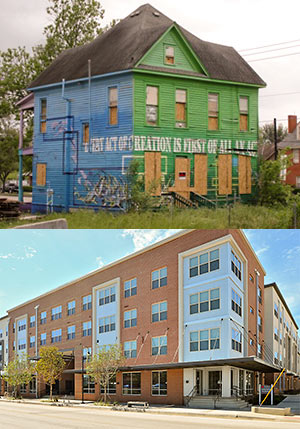 A report from Houston Community College says the commuter school is “in the early stages of planning” its own new dorm complex on the 6 acres of land it bought late last year at the northeast corner of Alabama and Almeda, just southeast of the system’s central campus. The only building currently on the site is the trashed but still brightly painted 107-year-old house at 1625 Alabama St. (pictured at top left) that most recently served as a temporary satellite space for DiverseWorks.
The dorms, which would include first-floor retail space and a parking garage, would be modeled after the Tobin Lofts at Alamo Colleges’ San Antonio College in San Antonio (bottom photo). They’d be built and leased out by a private company “until the business makes a predetermined return on its investment,” according to the report. “After approximately seven years, the complex would be given to HCC to own and manage from then on.” [The Chalkboard] Photos: HCC (top); Tobin Lofts (bottom)
A report from Houston Community College says the commuter school is “in the early stages of planning” its own new dorm complex on the 6 acres of land it bought late last year at the northeast corner of Alabama and Almeda, just southeast of the system’s central campus. The only building currently on the site is the trashed but still brightly painted 107-year-old house at 1625 Alabama St. (pictured at top left) that most recently served as a temporary satellite space for DiverseWorks.
The dorms, which would include first-floor retail space and a parking garage, would be modeled after the Tobin Lofts at Alamo Colleges’ San Antonio College in San Antonio (bottom photo). They’d be built and leased out by a private company “until the business makes a predetermined return on its investment,” according to the report. “After approximately seven years, the complex would be given to HCC to own and manage from then on.” [The Chalkboard] Photos: HCC (top); Tobin Lofts (bottom)
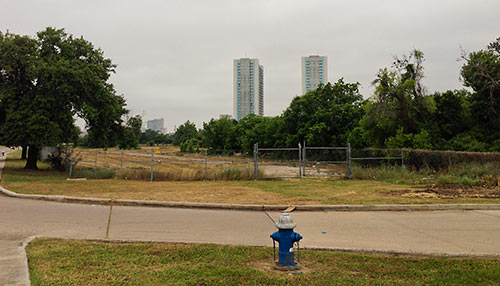
A reader reports seeing some activity on the long-vacant 9.177-acre melting-erlenmeyer-flask-shaped parcel of land at the northeast corner of Hwy. 288 and North MacGregor Way: no construction equipment yet, but crews were picking up trash and cutting grass. The Houston Community College system bought the property last November with plans to build a new medical-focused charter high school on the property.

Parents and students connected to Eastwood’s Lantrip Elementary School are showing off a new mulch-covered running track, separate wheelchair-ready path, and set of 12 raised garden beds on a decomposed-granite pad built this fall by volunteers from materials purchased with a $20,000 grant the school won in July. The garden-bed installation, pictured above in front of an older campus greenhouse, will also serve as an outdoor classroom for the school at the northern reaches of Telephone Rd. Also newly installed: a set of 20 new fruit trees with irrigation equipment sent by the Fruit Tree Planting Foundation, in addition to the earlier grant from Keep America Beautiful and the Lowe’s Foundation.

 The River Oaks Plant House — also known as the greenery purveyor that regularly festoons the corner of Westheimer and Buffalo Speedway with dancing bears and other fake topiary — will be closing up shop at the end December. Headmaster Mark Desjardins writes in an email that St. John’s School notified the owners of the more-than-30-year-old store in September that its lease would be terminated by December 31. The prep school had purchased the property from the Henry J. N. Taub family, along with the land under Blanco’s Bar & Grill, in a 13-acre deal completed exactly a year earlier.
The River Oaks Plant House — also known as the greenery purveyor that regularly festoons the corner of Westheimer and Buffalo Speedway with dancing bears and other fake topiary — will be closing up shop at the end December. Headmaster Mark Desjardins writes in an email that St. John’s School notified the owners of the more-than-30-year-old store in September that its lease would be terminated by December 31. The prep school had purchased the property from the Henry J. N. Taub family, along with the land under Blanco’s Bar & Grill, in a 13-acre deal completed exactly a year earlier.

The bids that were submitted to HISD yesterday to buy the Law Enforcement and Criminal Justice High School in Magnolia Grove rang up almost $5 million more than those the first time around in July: Neighboring St. Thomas High School is still in the running to purchase the 11-acre campus on Dickson St., just north of Memorial Dr. and Buffalo Bayou; it offered $45 million, compared with the $42 million the private school said it would pay in July. But St. Thomas was again outbid, this time by an entity called Elk Mountain Ltd. — connected, it appears, to the Gordy Oil Company — which submitted a flat $47,927,114.
IN PRAISE OF CARNEGIE VANGUARD’S MIXED-USE PARKING GARAGE 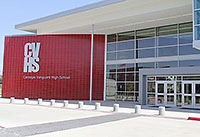 What does HISD have to show for that $805 million approved in 2007 for new school construction and renovation? MaryScott Hagle reviews the results at Lockhart, Herod, and Peck elementaries and gives props to RdlR Architects for the design of Carnegie Vanguard High School at 1501 Taft — though she seems most taken with the parking garage, which was, she writes, “originally planned for one story that grew to two when the City of Houston offered to pitch in, in exchange for community access to the school’s ball fields on the weekends. . . . Furthermore, the garage itself is dual-purpose: when the academic day is over and the students who park on the garage roof go home, the Carnegie tennis team takes over for practice.” [OffCite] Photo: HISD
What does HISD have to show for that $805 million approved in 2007 for new school construction and renovation? MaryScott Hagle reviews the results at Lockhart, Herod, and Peck elementaries and gives props to RdlR Architects for the design of Carnegie Vanguard High School at 1501 Taft — though she seems most taken with the parking garage, which was, she writes, “originally planned for one story that grew to two when the City of Houston offered to pitch in, in exchange for community access to the school’s ball fields on the weekends. . . . Furthermore, the garage itself is dual-purpose: when the academic day is over and the students who park on the garage roof go home, the Carnegie tennis team takes over for practice.” [OffCite] Photo: HISD
HOW ONE BUYER WOULD USE HISD’S LAW ENFORCEMENT HS PROPERTY 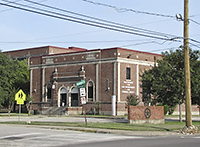 If the High School for Law Enforcement and Criminal Justice is sold to St. Thomas High School competitor AV Dickson Street, the investment company has said it plans to link the 11-acre Magnolia Grove property with the adjacent and recently purchased Bayou Park apartments at 4400 Memorial to create a mixed-use district: Alison Malkhassian of AV Dickson Street tells The Leader‘s Charlotte Aguilar that “the long-term goal . . . could be to create a 26-acre mixed-use luxury retail-office-residential development on the combined properties — a process that would take about a decade.” Yesterday, HISD received the 2nd round of bids: St. Thomas is offering $42 million, about $800,000 more than AV Dickson Street — but Aguilar suggests that the sale might come down to rent: St. Thomas said it would charge the school $225,000 a month to lease the space for the next 5 years, compared with $100,000 a month from AV Dickson Street, a difference of $7.5 million over that time. [The Leader; previously on Swamplot] Photo: HISD
If the High School for Law Enforcement and Criminal Justice is sold to St. Thomas High School competitor AV Dickson Street, the investment company has said it plans to link the 11-acre Magnolia Grove property with the adjacent and recently purchased Bayou Park apartments at 4400 Memorial to create a mixed-use district: Alison Malkhassian of AV Dickson Street tells The Leader‘s Charlotte Aguilar that “the long-term goal . . . could be to create a 26-acre mixed-use luxury retail-office-residential development on the combined properties — a process that would take about a decade.” Yesterday, HISD received the 2nd round of bids: St. Thomas is offering $42 million, about $800,000 more than AV Dickson Street — but Aguilar suggests that the sale might come down to rent: St. Thomas said it would charge the school $225,000 a month to lease the space for the next 5 years, compared with $100,000 a month from AV Dickson Street, a difference of $7.5 million over that time. [The Leader; previously on Swamplot] Photo: HISD

